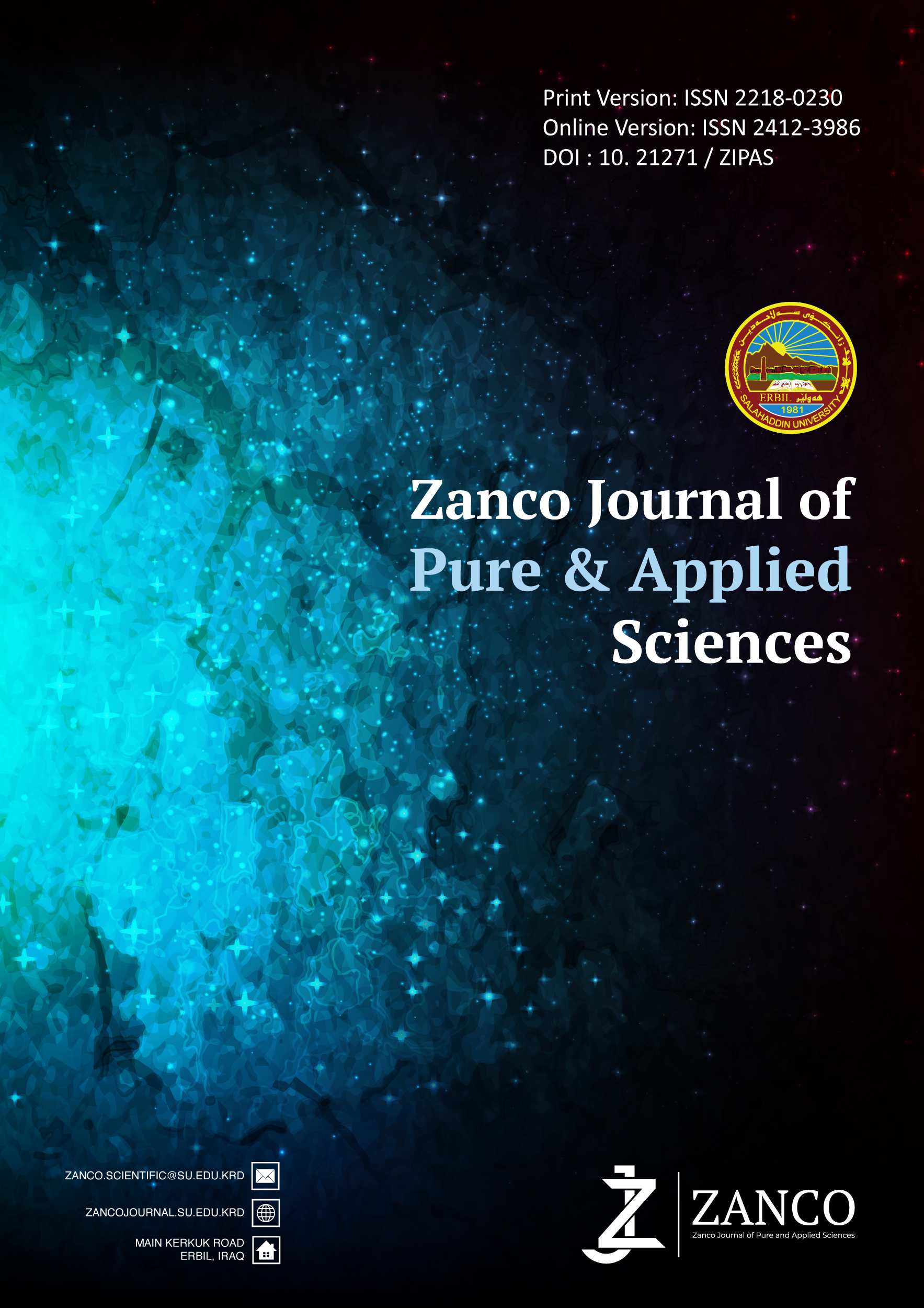A Study on the Allelopathic Effects of Wild Barley (Hordeum spontaneum) Residue Incorporated with Soil on Growth of Some Plant species
DOI:
https://doi.org/10.21271/ZJPAS.36.5.7Keywords:
Allelopathy, Plant residues, Hordeum spontaneum, Weed controlAbstract
This study examines the allelopathic effects of wild barley (Hordeum spontaneum) on the growth and yield of bread wheat (Triticum aestivum), barley (Hordeum vulgare), and wild barley (Hordeum spontaneum). The experiment was conducted in a greenhouse at Shamamar-Hawler/ Kurdistan Region of Iraq using a complete randomized factorial design (CRD) within 3 replications. The roots, shoots, and seeds of wild barley were dried, powdered, and added to the soil at different concentrations (0%, 10%, 20%, 30%, and 40%) in 500 g pots. Each pot was planted with 5 seeds, which were later reduced to 3 seedlings. Growth parameters such as shoot and root lengths, dry weights, number of tillers, weight of spikes, seeds number per plant, and biological yield was measured. The results indicated significant effects of wild barley residues on the studied crops. Wheat showed the highest roots, shoots and total lengths were (29.56 cm, 17.05 cm and 46.58 cm, respectively) and the highest shoots and roots dry weights were (0.24 g and 0.30 g). Barley showed the highest number of stems (1.96) but the lowest shoots and dry weights of roots were (0.11 g and 0.23 g). Wild barley had the highest biological weight and harvest index (HI). Among the plant parts, seed extracts significantly enhanced growth parameters, while roots and shoots extract had the greatest inhibitory effects as wild barley residue concentrations increased. Nevertheless, the HI showed a decline as the concentrations increased, suggesting a detrimental effect on growth efficiency. The study shows the potential of wild barley as a bio-herbicide, emphasizing its allelopathic effects. This suggests that agricultural practices should be carefully considered to maximize the efficiency of crops. Incorporating these results into precision agriculture can greatly improve crop management and increase yield.
References
ABDUL-BAKI, A. A. & ANDERSON, J. D. 4 – PHYSIOLOGICAL AND BIOCHEMICAL DETERIORATION OF SEEDS. 1972.
AL TAWAHA, A. R. & TURK, M. 2003. Allelopathic Effects of Black Mustard (Brassica nigra) on Germination and Growth of Wild Barley (Hordeum spontaneum). Journal of Agronomy and Crop Science, 189, 298-303.
ALI, K. & SAKRI, F. 2010. Influence of Cephalaria syriaca Residue Concentrations on Germination and Growth of Wheat, barley and some companion weeds. Zanco Journal of Salahaddin University, 22.
ALRAWIQ, N., GREIN, A., ALRAWIQ, H. & AL-ZWI, A. 2021. Allelopathic effect of alfalfa residues on germination and growth of barley.
ALSAADAWI, I. S. & RICE, E. L. 1982. Allelopathic effects of Polygonum aviculare L. II. Isolation, characterization, and biological activities of phytotoxins. Journal of Chemical Ecology, 8, 1011-1023.
AN, M., JOHNSON, I. R. & LOVETT, J. V. 2005. Mathematical Modelling of Allelopathy: IV. Assessment of Contributions of Competition and Allelopathy To Interference By Barley. Nonlinearity in Biology, Toxicology, Medicine, 3, 213-24.
BELZ, R. G. 2004. Evaluation of Allelopathic Traits in Triticum L. Spp. and Secale Cereale L.
BHADORIA, P. B. S. 2010. Allelopathy: A Natural Way towards Weed Management. Journal of Experimental Agriculture International, 1, 7-20.
CHANCELLOR, R. 1985. Allelopathy. By Elroy L. Rice. Orlando, Florida: Academic Press Inc. (1984), 2nd edition, pp. 422, $55, £45.20. Experimental Agriculture - EXP AGR, 21.
CHON, S. U. & KIM, J. D. 2002. Biological activity and quantification of suspected allelochemicals from alfalfa plant parts. Journal of Agronomy and Crop Science, 188, 281-285.
ECONOMOU, G., TZAKOU, O., GANI, A., YANNITSAROS, A. & BILALIS, D. 2002. Allelopathic effect of Conyza albida on Avena sativa and Spirodela polyrhiza. Journal of Agronomy and Crop Science, 188, 248-253.
FAROOQ, M., JABRAN, K., CHEEMA, Z., WAHID, A. & SIDDIQUE, K. 2011. The role of allelopathy in agricultural pest management. Pest Management Science, 67, 493-506.
FERREIRA, M. & REINHARDT, C. 2010. Field Assessment of Crop Residues for Allelopathic Effects on Both Crops and Weeds. Agronomy Journal, 102, 1593.
FIOREZE, S., VACARI, J., TUREK, T., MICHELON, L. & DRUN, R. 2019. Growth and yield parameters of white oat and wheat as affected by canola residues. Revista Ceres, 66, 416-421.
GNIAZDOWSKA, A. & BOGATEK, R. 2005. Allelopathic interactions between plants. Multi site action of allelochemicals. Acta Physiologiae Plantarum, 27, 395-407.
HAMBLIN, C. M. D. A. J. 1983. THE CONVERGENT EVOLUTION OF ANNUAL SEED CROPS IN AG R I C U LTU R E Academic Press, Inc.
HAMIDI, R., MAZAHERI, D., RAHIMIAN, H., ALIZADEH, H., GHADIRI, H. & ZEINALI, H. 2008. Phytotoxicity effects of soil amended residues of wild barley (Hordeum spontaneum Koch) on growth and yield of wheat (Triticum aestivum L.).
HAMIDI, R., MAZAHERI, D., RAHIMIAN, H., ALIZADEH, H. M., GHADIRI, H. & ZEINALY, H. 2006. INHIBITORY EFFECTS OF WILD BARLEY (Hordeum spontaneum Koch.) RESIDUES ON GERMINATION AND SEEDLING GROWTH OF WHEAT (Triticum aestivum L.) AND ITS OWN PLANT. Desert, 11, 35-43.
HASSANNEJAD, S., GHAFARBI, S. P. & LOTFI, R. 2013. Allelopathic effects of wheat and barley on emergence and seedling growth of some weed species. International Journal of Biosciences | IJB |, Vol. 3, No. 1, p. 128-134.
IQBAL, A. & FRY, S. 2012. Potent endogenous allelopathic compounds in Lepidium sativum seed exudate: Effects on epidermal cell growth in Amaranthus caudatus seedlings. Journal of experimental botany, 63, 2595-604.
IQBAL, A., SHAH, F., HAMAYUN, M., HAYAT, Z., ISLAM, B., REHMAN, G., KHAN, Z., SHAH, S., HUSSAIN, A. & JAMAL, Y. 2019. PLANTS ARE THE POSSIBLE SOURCE OF ALLELOCHEMICALS THAT CAN BE USEFUL IN PROMOTING SUSTAINABLE AGRICULTURE. Fresenius Environmental Bulletin, 28, 1040-1049.
LOVETT, J. V. & HOULT, A. H. C. 1994. Allelopathy and Self-Defense in Barley. Allelopathy. American Chemical Society.
MALLIK, A. U. 1992. Possible role of allelopathy in growth inhibition of softwood seedlings in Newfoundland. In: RIZVI, S. J. H. & RIZVI, V. (eds.) Allelopathy: Basic and Applied Aspects. Dordrecht: Springer Netherlands.
MIRKHAN, R. & ALI, K. 2024. The Allelopathic potential of Milk thistle (Silybum marianum) and Syrian thistle (Notobasis syriaca) on germination percentage, some growth characteristics and Allelopathy index of Wheat and Barley. ZANCO Journal of Pure and Applied Sciences.
NABY, K. & ALI, K. 2021. Allelopathic potential of Sorghum bicolor L. Root Exudates on Growth and Chlorophyll Content of Wheat and Some Grassy Weeds. IOP Conference Series: Earth and Environmental Science, 761, 012085.
NARWAL, S. S. 2012. Allelopathy in crop production, Scientific publishers.
NAWAZ, A., FAROOQ, M., ALAM, S. & CHEEMA, Z. 2014. Role of Allelopathy in Weed Management.
NORSWORTHY, J. K. 2003. Allelopathic Potential of Wild Radish (Raphanus raphanistrum). Weed Technology, 17, 307-313.
OLIVEIRA, A., RIBEIRO, J., PEREIRA, K. & SILVA, C. 2013. Effects of temperature on the germination of Diptychandra aurantiaca (Fabaceae) seeds. Acta Scientiarum. Agronomy, 35.
OVERLAND, L. 1966. THE ROLE OF ALLELOPATHIC SUBSTANCES IN THE “SMOTHER CROP” BARLEY. American Journal of Botany, 53, 423-432.
RASUL, S. & ALI, K. 2020. STUDY THE ALLELOPATHIC EFFECT OF RADISH BY INCORPORATE INTO SOIL ON SOME POACEAE SPECIES. Plant Archives, 20, 3624-3627.
RIGON, J., CAPUANI, S., CHERUBIN, M., WASTOWSKI, A. & ROSA, G. 2012. Allelopathic effects of aqueous extract of Brassica napus on germination of seeds of Phaseolus vulgaris. Revista Brasileira de Ciências Agrárias - Brazilian Journal of Agricultural Sciences, 7, 451-455.
SOLTYS-KALINA, D., KRASUSKA, U., BOGATEK, R. & GNIAZDOWSKA, A. 2013. Allelochemicals as Bioherbicides — Present and Perspectives.
SOLTYS-KALINA, D., RUDZIŃSKA-LANGWALD, A., GNIAZDOWSKA, A., WIŚNIEWSKA, A. & BOGATEK, R. 2012. Inhibition of tomato (Solanum lycopersicum L.) root growth by cyanamide is due to altered cell division, phytohormone balance and expansin gene expression. Planta, 236, 1629-38.
TAWAHA, A. & TURK, M. 2003. Allelopathic effects of black mustard (Brassica nigra) on germination and growth of wild barley (Hordeum spontaneum). Journal of Agronomy and Crop Science, 189, 298-303.
TAWFEEQ, D. J. & ALI, K. A. 2017. Study the Allelopathic Potential of Wild Barley (Hordeum spontaneum Koch.) as an Integrated Weed Management (IWM) Tool. ZANCO Journal of Pure and Applied Sciences, 28, 1-21.
WEINBERG, S. L. & ABRAMOWITZ, S. K. 2008. Statistics using SPSS: An integrative approach, 2nd ed, New York, NY, US, Cambridge University Press.
WEIR, T. L., PARK, S.-W. & VIVANCO, J. M. 2004. Biochemical and physiological mechanisms mediated by allelochemicals. Current Opinion in Plant Biology, 7, 472-479.
WEN, J. & RENEE, L. 2007. Ascertain the Effect of PEG and Exogenous ABA on Rice Growth at Germination Stage and Their Contribution to Selecting Drought Tolerant Genotypes. Asian Journal of Plant Sciences, 6.
Y. ASHRAFI, Z., MASHHADI, H. & SADEGHI, S. 2007. Allelopathic effects of barley (Hordeum vulgare) on germination and growth of wild barley (Hordeum spontaneum). Pak. J. Weed Sci. Res, 13, 99-112.
ZIMDAHL, R. L. 2018. Integrated weed management for sustainable agriculture.
Downloads
Published
How to Cite
Issue
Section
License
Copyright (c) 2024 Didar J. Tawfeeq, Kawa A. Ali

This work is licensed under a Creative Commons Attribution 4.0 International License.














